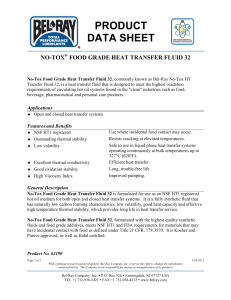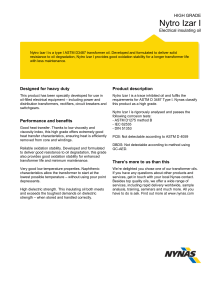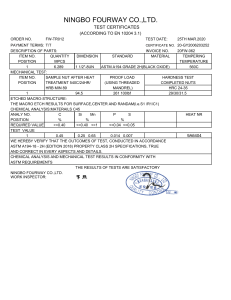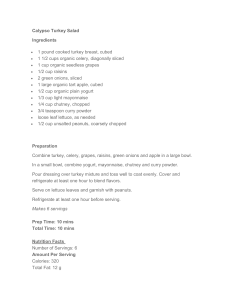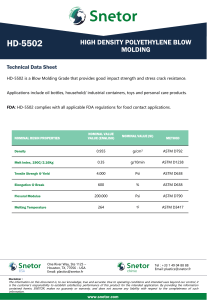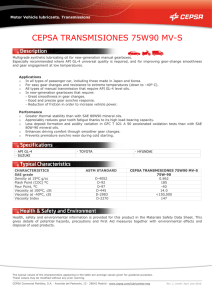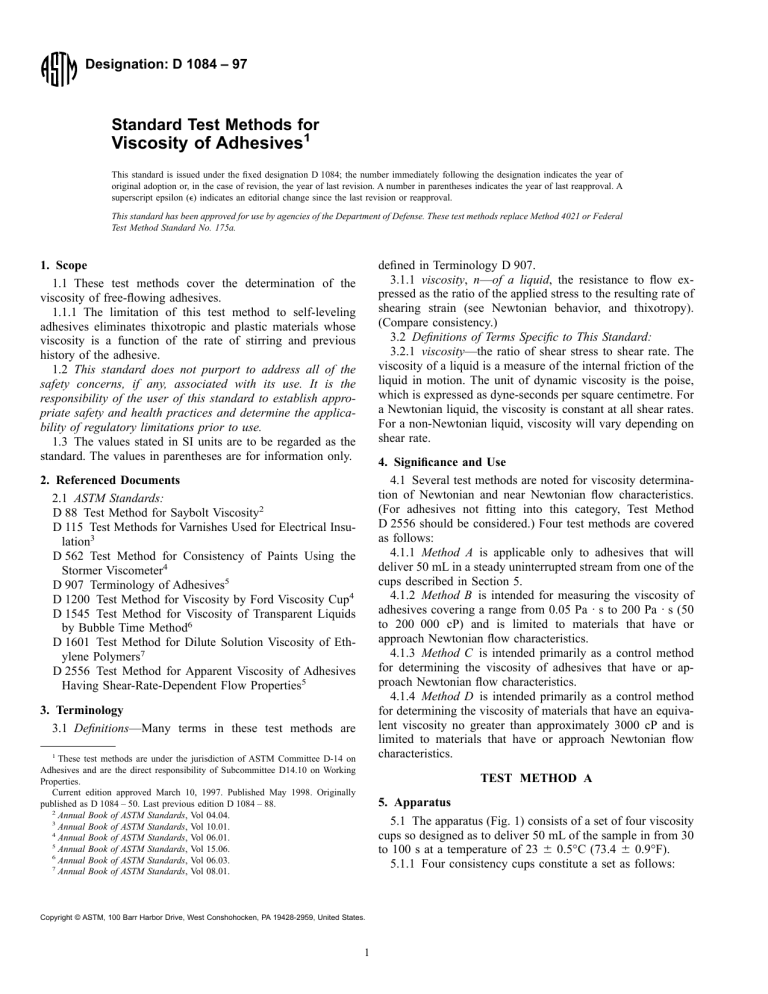
Designation: D 1084 – 97 Standard Test Methods for Viscosity of Adhesives1 This standard is issued under the fixed designation D 1084; the number immediately following the designation indicates the year of original adoption or, in the case of revision, the year of last revision. A number in parentheses indicates the year of last reapproval. A superscript epsilon (e) indicates an editorial change since the last revision or reapproval. This standard has been approved for use by agencies of the Department of Defense. These test methods replace Method 4021 or Federal Test Method Standard No. 175a. defined in Terminology D 907. 3.1.1 viscosity, n—of a liquid, the resistance to flow expressed as the ratio of the applied stress to the resulting rate of shearing strain (see Newtonian behavior, and thixotropy). (Compare consistency.) 3.2 Definitions of Terms Specific to This Standard: 3.2.1 viscosity—the ratio of shear stress to shear rate. The viscosity of a liquid is a measure of the internal friction of the liquid in motion. The unit of dynamic viscosity is the poise, which is expressed as dyne-seconds per square centimetre. For a Newtonian liquid, the viscosity is constant at all shear rates. For a non-Newtonian liquid, viscosity will vary depending on shear rate. 1. Scope 1.1 These test methods cover the determination of the viscosity of free-flowing adhesives. 1.1.1 The limitation of this test method to self-leveling adhesives eliminates thixotropic and plastic materials whose viscosity is a function of the rate of stirring and previous history of the adhesive. 1.2 This standard does not purport to address all of the safety concerns, if any, associated with its use. It is the responsibility of the user of this standard to establish appropriate safety and health practices and determine the applicability of regulatory limitations prior to use. 1.3 The values stated in SI units are to be regarded as the standard. The values in parentheses are for information only. 4. Significance and Use 4.1 Several test methods are noted for viscosity determination of Newtonian and near Newtonian flow characteristics. (For adhesives not fitting into this category, Test Method D 2556 should be considered.) Four test methods are covered as follows: 4.1.1 Method A is applicable only to adhesives that will deliver 50 mL in a steady uninterrupted stream from one of the cups described in Section 5. 4.1.2 Method B is intended for measuring the viscosity of adhesives covering a range from 0.05 Pa · s to 200 Pa · s (50 to 200 000 cP) and is limited to materials that have or approach Newtonian flow characteristics. 4.1.3 Method C is intended primarily as a control method for determining the viscosity of adhesives that have or approach Newtonian flow characteristics. 4.1.4 Method D is intended primarily as a control method for determining the viscosity of materials that have an equivalent viscosity no greater than approximately 3000 cP and is limited to materials that have or approach Newtonian flow characteristics. 2. Referenced Documents 2.1 ASTM Standards: D 88 Test Method for Saybolt Viscosity2 D 115 Test Methods for Varnishes Used for Electrical Insulation3 D 562 Test Method for Consistency of Paints Using the Stormer Viscometer4 D 907 Terminology of Adhesives5 D 1200 Test Method for Viscosity by Ford Viscosity Cup4 D 1545 Test Method for Viscosity of Transparent Liquids by Bubble Time Method6 D 1601 Test Method for Dilute Solution Viscosity of Ethylene Polymers7 D 2556 Test Method for Apparent Viscosity of Adhesives Having Shear-Rate-Dependent Flow Properties5 3. Terminology 3.1 Definitions—Many terms in these test methods are 1 These test methods are under the jurisdiction of ASTM Committee D-14 on Adhesives and are the direct responsibility of Subcommittee D14.10 on Working Properties. Current edition approved March 10, 1997. Published May 1998. Originally published as D 1084 – 50. Last previous edition D 1084 – 88. 2 Annual Book of ASTM Standards, Vol 04.04. 3 Annual Book of ASTM Standards, Vol 10.01. 4 Annual Book of ASTM Standards, Vol 06.01. 5 Annual Book of ASTM Standards, Vol 15.06. 6 Annual Book of ASTM Standards, Vol 06.03. 7 Annual Book of ASTM Standards, Vol 08.01. TEST METHOD A 5. Apparatus 5.1 The apparatus (Fig. 1) consists of a set of four viscosity cups so designed as to deliver 50 mL of the sample in from 30 to 100 s at a temperature of 23 6 0.5°C (73.4 6 0.9°F). 5.1.1 Four consistency cups constitute a set as follows: Copyright © ASTM, 100 Barr Harbor Drive, West Conshohocken, PA 19428-2959, United States. 1 D 1084 All dimensions are in mm FIG. 1 Consistency Cups and Apparatus Assembly (Test Method A) First Cup Second cup Third cup Fourth cup 7.1.2 Conditioning procedure used for samples prior to testing, 7.1.3 Number of tests made, and 7.1.4 Average consistency in seconds and the number of the viscosity cup used. Diameter of Orifice, in. 0.07 6 0.0001 0.10 6 0.0001 0.15 6 0.0001 0.25 6 0.0001 5.1.2 Cups made of brass or bronze. Orifice disks made of 18 % Chromium, 8 % Nickel stainless steel. The diameter of the Orifice pressed in the cup shall be stamped on the cup 5.1.3 Fractional dimensions subject to permissible variations of 60.01 in., unless otherwise specified. TEST METHOD B 8. Apparatus 8.1 Viscometer—The apparatus consists of a Brookfield synchrolectric viscosimeter,8 or an equivalent instrument. A series of spindles with various sized disks is provided with each instrument covering a standard range of viscosities. Scored, warped, or otherwise damaged spindles are not to be used. The calibration sleeve will be used when the values are to be reported in actual centipoise. This spindle guard ensures uniform edge effects. By mutual agreement, the instrument may be used without the calibration sleeve, but the values obtained must be reported in apparent centipoises. Use a standard container and take care to center the spindle in the container. A complete description of the container must be include in the report. 8.2 Thermometer—A precision thermometer with graduations not greater than 0.2°C (0.36°F) divisions. 6. Procedure 6.1 Bring the sample to be tested and the viscosity cup to a temperature of 23 6 0.5°C (73.4 6 0.9°F) (preferably in a constant-temperature room). Then mount the consistency cup in the clamp provided for the purpose and place the receiving cylinder in position. With the outlet of the cup closed by means of the finger, pour the sample into the cup until it is filled to overflowing. Strike off the excess with a straightedge, and then remove the finger from over the outlet and allow the sample to flow into the receiving cylinder. Determine the number of seconds from the time the finger is removed from the orifice until the top of the meniscus reaches to 50-mL mark on the cylinder by a stop watch and record as the viscosity of the material. 9. Calibration 9.1 When used for referee purposes, calibrate the instrument 7. Report 7.1 Report the following: 7.1.1 Complete identification of the adhesive tested, including type, source, manufacturer’s code numbers, form, date of test, date of manufacture, etc., 8 2 Manufactured by the Brookfield Engineering Laboratories, Stoughton, MA. D 1084 by measuring the viscosity of a standard oil,9 using the same spindle and speed of rotation employed to measure the sample. If the viscosity of the oil as read by the instrument differs by more than 2 % and less than 20 % from the certified viscosity of the oil, calculate the viscosity of the unknown by means of the appropriate correction factor. Investigate a difference of more than 20 %, and determine a calibration curve using at least two standard oils with viscosities on either side of the sample for the instrument. used in the preparation of the adhesive mix, 11.1.6 Temperature of the sample at the conclusion of the test, 11.1.7 Number of tests made, and 11.1.8 Viscosity in actual or apparent centipoises, together with the range of the observation in centipoises. TEST METHOD C 12. Apparatus 12.1 Viscometer—A Stormer viscosimeter with double flag paddle-type rotor as specified in Test Method D 562, or an equivalent apparatus, in good repair and a spindle that spins freely when started without the paddle. 12.2 Containers—Round friction-top metal cans having a capacity of 1 qt (0.9 L). Nonstandard containers may be used by mutual agreement, when necessary to prevent corrosion or other deleterious effects of metal cans. 12.3 Thermometer—A precision thermometer with graduations not greater than 0.2°C (0.36°F) divisions. 12.4 Timer—A stop watch or suitable timer measuring to 0.2 s. 10. Procedure 10.1 Conditioning—Bring the sample of the adhesive and the instrument to a temperature of 23 6 0.5°C (73.4°F) (preferably in a constant-temperature room), and maintain the sample uniformly at this standard temperature throughout the test. Protect adhesives containing volatile solvents from evaporation during conditioning. If special conditioning methods are necessary, such as the use of a circulating water bath, report in 11.1.5. 10.2 Adjustment—Select a spindle suitable to the viscosity range of the material and firmly fit it into the shaft extension which comes down through the center of the dial casing. 10.3 Determination—Insert the spindle perpendicularly into the material to be tested until immersed to the depth indicated by the groove cut into the shaft. Press down the clutch lever and start the motor by snapping the toggle switch. Then release the lever and allow rotation to continue until the pointer has reached the position where it is stationary in relation to the rotating dial. Again press down the clutch lever and snap the switch off. If the pointer is not in view when the dial has come to rest, the motor should be started again and allowed to run until the pointer reaches the vision plate, keeping the clutch lever depressed. Take the reading at the pointer. A check reading can also be made by restarting the motor before releasing the clutch. If the pointer makes a complete turn of the dial, this indicates that the viscosity is too great for the capacity of the spindle used. A slower speed of rotation or a spindle with a greater range should be used. If the pointer moves less than 20 % of the way around the dial, this indicates that the viscosity is too low for accurate measurement with the spindle or rate of rotation used. A faster speed of rotation or a spindle with a lower range should be used. Make a minimum of three readings. Some instruments have two concentric scales, and great care should be taken to read the pointer on the correct scale as specified by the manufacturer for the spindle used. 13. Procedure 13.1 Conditioning—Bring the containers holding the samples to be tested and the paddle to be used to a temperature of 23 6 0.5°C (73.4°F) (preferably in a constant-temperature room), and maintain the sample uniformly at this standard temperature throughout the test. Protect adhesives containing volatile solvents from evaporation during conditioning. If special conditioning methods are necessary, such as the use of a circulating water bath. Report this in 14.1.2. 13.2 Adjustment—Prepare the instrument for use by raising the weight to the top by winding up the cord with the ratchet provided for that purpose. Set the revolution counter at 10 revolutions below the zero mark. Use a falling weight of such magnitude that a minimum time of 20 s is required for 100 revolutions of the paddle when the test is conducted as specified in 13.2. Choose the weight from the series 50, 100, 200, 500, and 1000 g. Fasten the paddle securely on the shaft, place the container on the platform, and raise until the surface of the adhesive just reaches the mark on the stem of the paddle. This ensures uniform depth of immersion of the paddle. 13.3 Determination—Release the brake on the large cog wheel, and start the timing device when the needle on the revolution counter passes the zero mark. Note the time for 100 revolutions accurately to the closest 0.2 s. Make a minimum of three determinations. 11. Report 11.1 Report the following: 11.1.1 Complete identification of the adhesive tested, including type, source, manufacturer’s code numbers, form, date of test, date of manufacture, etc., 11.1.2 Name and model number of the instrument used, 11.1.3 Number of the spindle used, and specify use of spindleguard, 11.1.4 Speed used, 11.1.5 Conditioning procedure employed, including details of the container and time elapsed between various operations 9 14. Report 14.1 Report the following: 14.1.1 Complete identification of the adhesive tested, including type, source, manufacturer’s code numbers, form, date of test, date of manufacture, etc., 14.1.2 Conditioning procedure employed, including time elapsed between various operations used in the preparation of the adhesive mix, 14.1.3 Details of nonstandard containers, if used, 14.1.4 Temperature of the sample at the conclusion of the test, Available from the Cannon Instrument Co., Box 16, State College, PA 16801. 3 D 1084 15.2 The following figures are given only for the purpose of selecting the proper viscometer. They are not intended for use in converting centipoises to Zahn seconds. 14.1.5 Weight used, 14.1.6 Number of tests made, and 14.1.7 Average viscosity in seconds for 100 revolutions, together with the range of the observations. Orifice Size, in. (mm) 0.0788 (2.002) 0.1082 (2.748) 0.1487 (3.777) 0.1684 (4.277) 0.2072 (5.263) TEST METHOD D 15. Apparatus 15.1 The apparatus (Fig. 2) consists of a set of five Zahn viscosity cups10 so designed as to allow a sample to flow through the calibrated orifice in approximately 1 min or less, best results being obtained when the flow time is between 20 and 40 s. 15.1.1 Five viscosity cups constitute a set as follows: 0.0788 0.1082 0.1487 0.1684 0.2072 2.002 2.748 3.777 4.277 5.263 15.1.2 Cups shall be made of stainless steel, 0.050 in. (1.27 mm) thick. The number of the cup shall be stamped on a plate on the cup. 10 (Range, cP) (20 to 85) (30 to 170) (170 to 550) (200 to 900) (250 to 1200) (and above) Range, Zahn’s 40 to 85 20 to 70 25 to 60 20 to 65 15 to 60 16. Procedure 16.1 Conditioning—Bring the sample of the adhesive and the cup to a temperature of 23 6 0.5°C (73.4 6 0.9°F), preferably in a constant-temperature room, and maintain the sample uniformly at this standard temperature throughout the test. Other temperatures of test are optional. Protect adhesives containing volatile solvents from evaporation during conditioning. If special conditioning methods are necessary, such as the use of a circulating water bath, they shall be specified in 17.1.2. 16.2 Determination—Hold the viscometer in a vertical position (by means of a small ring at the end of the handle) and completely immerse the cup into the sample being tested. Lift the viscometer out of the sample (Note 1). Determine by means of a stop watch the number of seconds from the time the top edge of the viscometer cup breaks the surface until the steady flow from the orifice first breaks, and record this time as the consistency of the material. Record the temperature of the Diameter of Orifices in. + 0.0003 mm + 0.0076 – 0.0002 –0.0051 First cup Second cup Third cup Fourth cup Fifth cup Range Pa · S 0.02 to 0.085 0.03 to 0.170 0.120 to 0.550 0.200 to 0.900 0.250 to 1.200 (and above) Available from Paul N. Gardner Co., Pompano Beach, FL. All dimensions are in mm FIG. 2 Viscosity Cups (Test Method D) 4 D 1084 sample and the number of the cup. 17.1.4 Average viscosity in seconds and the number of the viscosity cup used. NOTE 1—Time of removal must be rapid. Unless build-up of adhesive on the side of the cup occurs, the time of removal should be about 1 s. PRECISION AND BIAS 17. Report 17.1 Report the following: 17.1.1 Complete identification of the adhesive tested, including type, source, manufacturer’s code numbers, form, date of test, date of manufacture, etc., 17.1.2 Conditioning procedure employed for samples prior to testing, 17.1.3 Number of tests made, and 18. Precision and Bias 18.1 At the present time there is no basis for a statement of precision and bias concerning the reproducibility of results among laboratories. 19. Keywords 19.1 adhesive; viscosity APPENDIX (Nonmandatory Information) X1. REFERENCE VISCOSITY METHODS X1.1 Reference viscosity methods giving equipment used are shown on the following table: Test Method for Refers to Viscosity of Transparent Liquids by Bubble Time Method Saybolt Viscosity Dilute Solution Viscosity of Ethylene Polymers Viscosity of Paints, Varnishes, and Lacquers by Ford Viscosity Cup Varnishes Used for Electrical Insulation D 1545 D 88 D 1601 D 1200 D 115 Equipment Used Gardner-Holdt tubes Saybolt viscometer Modified Ubbelohde viscometer Ford cup MacMichael viscosimeter The American Society for Testing and Materials takes no position respecting the validity of any patent rights asserted in connection with any item mentioned in this standard. Users of this standard are expressly advised that determination of the validity of any such patent rights, and the risk of infringement of such rights, are entirely their own responsibility. This standard is subject to revision at any time by the responsible technical committee and must be reviewed every five years and if not revised, either reapproved or withdrawn. Your comments are invited either for revision of this standard or for additional standards and should be addressed to ASTM Headquarters. Your comments will receive careful consideration at a meeting of the responsible technical committee, which you may attend. If you feel that your comments have not received a fair hearing you should make your views known to the ASTM Committee on Standards, at the address shown below. This standard is copyrighted by ASTM, 100 Barr Harbor Drive, PO Box C700, West Conshohocken, PA 19428-2959, United States. Individual reprints (single or multiple copies) of this standard may be obtained by contacting ASTM at the above address or at 610-832-9585 (phone), 610-832-9555 (fax), or service@astm.org (e-mail); or through the ASTM website (www.astm.org). 5
